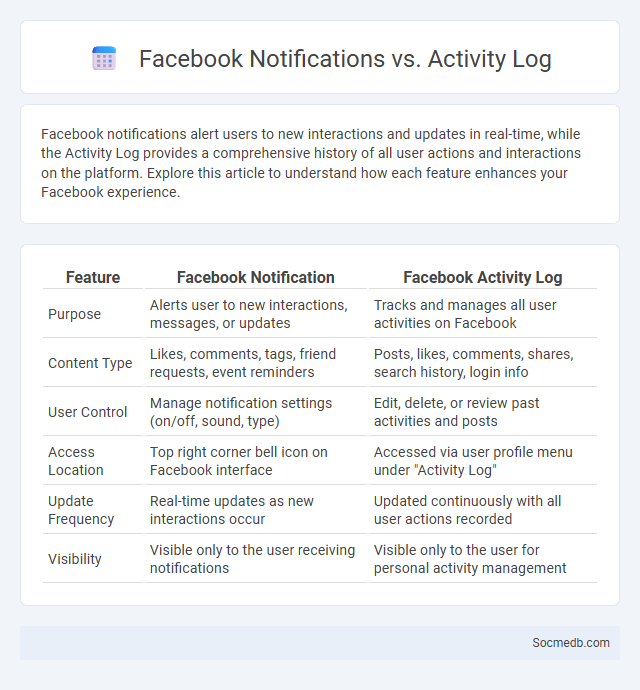
Photo illustration: Facebook Notification vs Activity Log
Facebook notifications alert users to new interactions and updates in real-time, while the Activity Log provides a comprehensive history of all user actions and interactions on the platform. Explore this article to understand how each feature enhances your Facebook experience.
Table of Comparison
| Feature | Facebook Notification | Facebook Activity Log |
|---|---|---|
| Purpose | Alerts user to new interactions, messages, or updates | Tracks and manages all user activities on Facebook |
| Content Type | Likes, comments, tags, friend requests, event reminders | Posts, likes, comments, shares, search history, login info |
| User Control | Manage notification settings (on/off, sound, type) | Edit, delete, or review past activities and posts |
| Access Location | Top right corner bell icon on Facebook interface | Accessed via user profile menu under "Activity Log" |
| Update Frequency | Real-time updates as new interactions occur | Updated continuously with all user actions recorded |
| Visibility | Visible only to the user receiving notifications | Visible only to the user for personal activity management |
Introduction to Facebook Notifications and Activity Log
Facebook notifications keep you instantly informed about likes, comments, friend requests, and event reminders, enhancing your social media experience. The Activity Log allows you to review and manage your interactions, posts, and search history, giving you control over your digital footprint. By exploring these features, you can efficiently track and customize your Facebook activity to suit your preferences.
What Are Facebook Notifications?
Facebook notifications are real-time alerts that inform users about activities related to their account, such as comments, likes, friend requests, and event updates. These notifications are designed to enhance user engagement by providing timely information on interactions and important updates within the Facebook platform. Managing notification settings allows users to customize alerts for posts, messages, and app activity to suit their preferences and avoid notification overload.
Understanding the Facebook Activity Log
The Facebook Activity Log meticulously records every action you take, including posts, comments, likes, and shares, providing a comprehensive archive of your online interactions. This feature allows you to review, manage, and delete specific activities to maintain your desired privacy and content visibility. Accessing Your Activity Log enables precise control over your digital footprint and helps optimize your social media experience effectively.
Key Differences: Notifications vs Activity Log
Notifications in social media platforms serve as real-time alerts to user interactions such as likes, comments, and mentions, ensuring immediate engagement and response. The Activity Log, by contrast, provides a comprehensive and chronological record of all user actions and interactions, allowing detailed review and management of account history. While notifications prioritize current, actionable updates, the Activity Log focuses on long-term tracking and control of social media activity data.
Types of Facebook Notifications Explained
Facebook notifications include several types such as friend requests, message alerts, event reminders, and activity updates like likes, comments, and shares on your posts. Each notification type is designed to keep users engaged by providing real-time interactions, group activity alerts, and personalized content suggestions. Understanding these categories helps optimize user experience, ensuring timely responses and enhanced social connectivity on the platform.
How the Activity Log Tracks Your Actions
The Activity Log meticulously records every interaction you make on social media, including likes, comments, shares, and posts, providing a comprehensive timeline of your digital footprint. It allows you to review, manage, and delete specific activities to maintain control over your online presence. By accessing this log, you can ensure your profile reflects the image you want to present and safeguard your privacy effectively.
Managing and Customizing Notifications
Managing and customizing social media notifications allows users to control the frequency and type of alerts they receive, enhancing user experience and reducing digital distractions. Platforms like Facebook, Instagram, and Twitter offer settings to personalize notifications based on mentions, messages, likes, or comments. Efficient notification management increases user engagement while maintaining balance between connectivity and privacy.
Reviewing Your Activity Log for Account Security
Regularly reviewing your social media activity log is vital for maintaining account security and identifying unauthorized access or suspicious actions. Your activity log provides a detailed history of posts, likes, comments, and login records, helping you detect any unusual behavior quickly. By monitoring this data consistently, you can take immediate action to protect your personal information and enhance your overall digital safety.
User Privacy: Notification Settings vs Activity Log Settings
User privacy on social media heavily relies on managing notification settings, which control alerts for mentions, messages, and app activity, reducing unsolicited data exposure. Activity log settings offer users detailed control over visibility and history of interactions, including posts, likes, and searches, enabling precise privacy customization. Balancing these settings empowers users to protect personal information while maintaining a tailored social media experience.
Best Practices for Monitoring Facebook Notifications and Activity Logs
Effective monitoring of Facebook notifications and activity logs enhances your social media management by ensuring timely responses and maintaining account security. Regularly review activity logs to track posts, comments, and login history, helping you identify unauthorized access or unusual actions. Utilize Facebook's notification settings to customize alerts, so you stay informed about interactions relevant to your content and audience engagement.
 socmedb.com
socmedb.com